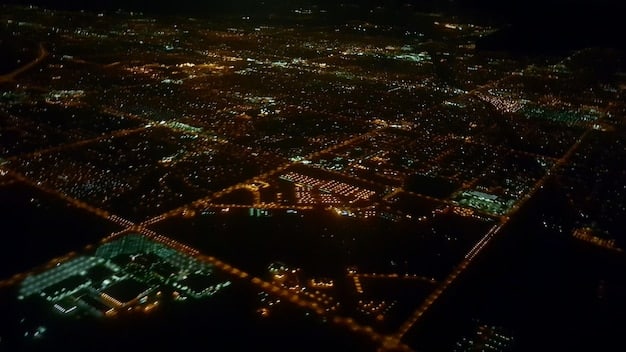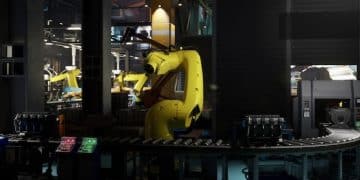US Space Tech: Commercial Opportunities Beyond Earth

The evolving landscape of US space technology is rapidly transforming, moving beyond government dominance to embrace a burgeoning commercial sector that presents unprecedented investment and innovation opportunities across various industries beyond Earth.
The dawn of a new space era is upon us, profoundly reshaping industries and economies worldwide. Driven by ambitious private enterprise and innovative technologies, the landscape of US Space Tech: Commercial Opportunities Beyond Earth is expanding at an unprecedented pace. This sector, once largely the domain of government agencies, is now a vibrant ecosystem teeming with potential, attracting significant investment and fostering groundbreaking advancements.
the new space economy: a shifting paradigm
For decades, space exploration and development were primarily federal endeavors, with NASA and military agencies leading the charge. Today, however, we are witnessing a profound shift, commonly referred to as the “New Space Economy.” This transformation is fueled by private companies that are not only complementing government efforts but are also pioneering entirely new markets and applications in space.
This paradigm shift is driven by several key factors, including technological advancements, reduced launch costs, and a growing recognition of space as an economic frontier. Legacy aerospace companies are adapting, while a new generation of startups is emerging, all vying for a slice of the pie. The emphasis has moved from purely scientific exploration to leveraging space for commercial gain, benefiting humanity on Earth and beyond.
drivers of commercial space growth
Several forces are propelling the commercial space sector forward, each playing a critical role in its expansion.
- Technological Innovation: Miniaturization of satellites, reusable rockets, and advancements in artificial intelligence and propulsion systems are making space access more affordable and efficient.
- Decreased Launch Costs: Companies like SpaceX have drastically reduced the cost of launching payloads into orbit, opening up opportunities for a wider range of businesses and research initiatives.
- Increased Private Investment: Venture capital and private equity firms are pouring billions into space companies, signaling strong confidence in the sector’s long-term profitability.
- Government Support and Partnerships: While the private sector leads, government agencies continue to provide vital support through contracts, data sharing, and regulatory frameworks that foster growth.
This intricate interplay of innovation, investment, and collaboration is creating fertile ground for commercial ventures. The competition is fierce, but it’s also fostering an environment of rapid innovation, pushing the boundaries of what is possible in space.
Ultimately, the New Space Economy isn’t just about launching rockets; it’s about building an entire economic ecosystem beyond our planet. This includes everything from in-orbit manufacturing and asteroid mining to space tourism and lunar habitats, each presenting unique challenges and immense commercial potential.
in-orbit manufacturing and resource utilization
One of the most transformative areas of commercial space operations is in-orbit manufacturing (IOM) and space resource utilization (ISRU). These concepts move beyond simply launching finished goods into space, envisioning a future where materials are processed, and products are assembled or even printed in the unique environment of microgravity or directly from extraterrestrial resources.
The advantages of IOM are compelling. Manufacturing in microgravity can unlock properties in materials not achievable on Earth, leading to stronger alloys, purer pharmaceuticals, and more efficient optical fibers. Furthermore, assembling large structures in space avoids the size constraints of launch vehicle fairings, enabling the creation of massive satellites or telescopes that would be impossible to deploy from Earth.
the promise of space-based production
The ability to manufacture in space could revolutionize several industries.
- Advanced Materials: Microgravity allows for the creation of perfect crystals, high-purity optical fibers, and novel alloys with superior properties impossible to replicate under Earth’s gravity.
- Pharmaceuticals: Protein crystallization in space can yield more precise drug structures, potentially leading to the development of more effective medicines.
- Large-Scale Structures: Antennas, solar arrays, and even entire space stations can be assembled in orbit, overcoming payload volume limitations of rocket launches.
- Recycling and Repair: Orbiting facilities could become hubs for repairing existing satellites or recycling space debris, fostering a more sustainable space environment.
Beyond orbital manufacturing, the concept of ISRU offers the tantalizing prospect of “living off the land” in space. This means utilizing resources found on the Moon, Mars, or asteroids, such as water ice for propellant and life support, and regolith for construction materials. This would drastically reduce the cost and logistical challenges of lunar or Martian missions by eliminating the need to transport all necessities from Earth.

The development of infrastructure to support ISRU, from mining robotics to processing plants on celestial bodies, represents a significant commercial opportunity. Companies are already investing in technologies to extract water from lunar poles and to process Martian soil for future human settlements. This reduces reliance on costly Earth-based supplies and truly paves the way for extended human presence in space, opening up new frontiers for businesses and economies.
satellite broadband and global connectivity
The demand for global connectivity is insatiable, and space technology is poised to meet this need like never before. Satellite broadband constellations, notably those being developed by US companies, promise to deliver high-speed, low-latency internet access to every corner of the globe, including remote and underserved areas where terrestrial infrastructure is impractical or impossible.
This is not the satellite internet of old, characterized by slow speeds and high latency. The new generation of constellations operates in Low Earth Orbit (LEO), much closer to Earth, significantly reducing signal delay and enabling speeds comparable to traditional terrestrial broadband. This leap in performance unlocks vast commercial opportunities and societal benefits.
shaping the future of connectivity
The implications of ubiquitous global satellite broadband are profound, extending far beyond simple internet access.
- Bridging the Digital Divide: Providing internet access to billions who currently lack it, fostering economic development and educational opportunities in remote regions.
- IoT and M2M Connectivity: Enabling machine-to-machine communication and the Internet of Things (IoT) on a massive scale, supporting global asset tracking, environmental monitoring, and smart infrastructure.
- Enhanced Disaster Relief: Maintaining critical communication lines during natural disasters when ground infrastructure is compromised.
- Maritime and Aviation Internet: Delivering reliable, high-speed internet to ships and aircraft, transforming commercial operations and passenger experience.
Companies like Starlink (SpaceX) are rapidly deploying thousands of satellites, creating a dense mesh network in orbit. Other players, including OneWeb and Amazon’s Project Kuiper, are also making significant headway. The competition is driving innovation, making the technology more robust and affordable.
The business models extend beyond simply selling internet subscriptions. There are opportunities in providing specialized services for specific industries, developing complementary ground infrastructure, and creating new applications that leverage global, always-on connectivity. The sheer scale of this endeavor, and the foundational service it provides, positions satellite broadband as one of the most lucrative and impactful commercial space opportunities.
space tourism and human spaceflight
Once the exclusive domain of highly trained astronauts, human spaceflight is rapidly entering the commercial realm. Space tourism is no longer a futuristic fantasy but a nascent industry seeing its first forays into suborbital and orbital travel. Companies are developing various vehicles and experiences, catering to a diverse clientele ranging from the ultra-wealthy to ordinary citizens dreaming of seeing Earth from above.
This sector is expanding to include not just tourism but also private astronaut missions for scientific research, crew transportation to space stations, and eventually, habitats and hotels in orbit or on celestial bodies. The democratization of access to space is perhaps one of the most visible and exciting aspects of the New Space Economy.
market segments in human spaceflight
The commercial human spaceflight market is segmenting into distinct offerings, each with its own niche.
- Suborbital Flights: Brief trips to the edge of space, offering a few minutes of weightlessness and stunning views of Earth, primarily through companies like Virgin Galactic and Blue Origin.
- Orbital Tourism: More extensive journeys into orbit, potentially involving stays on private space stations, offered by companies like Axiom Space in partnership with SpaceX and NASA.
- Private Astronaut Missions: Dedicated flights for individuals or organizations to conduct research, filmmaking, or other activities on orbital platforms.
- Space Habitats and Hotels: Long-term vision includes developing expandable modules and dedicated space hotels for extended stays, revolutionizing hospitality beyond Earth.
Beyond the direct revenue from tickets, commercial human spaceflight stimulates growth in supporting industries, including specialized training, unique apparel, high-tech life support systems, and even space catering. The economic ripple effect is significant, creating jobs and fostering innovation across various sectors.
While challenges remain, particularly around safety, cost, and regularity of flights, continuous technological advancements and increasing investment are propelling this industry forward, promising to make human presence in space more accessible and routine than ever before.
earth observation and remote sensing
Earth observation (EO) and remote sensing from space have been vital tools for decades, but the commercial sector is now dramatically expanding their capabilities and applications. Driven by constellations of smaller, more affordable satellites, private companies are collecting vast amounts of data about our planet at unprecedented frequency and resolution. This data offers critical insights for a myriad of industries, from agriculture and urban planning to disaster response and climate monitoring.
The shift from large government-owned satellites to smaller, privately operated ones has democratized access to EO data, making it more available and affordable for businesses and researchers worldwide. This democratization is sparking a boom in data analytics and value-added services.
diverse applications of spatial data
The commercial applications of Earth observation data are incredibly diverse and continue to expand.
- Agriculture: Monitoring crop health, predicting yields, optimizing irrigation, and detecting disease outbreaks contribute to food security efficiencies.
- Urban Planning: Tracking urban sprawl, assessing infrastructure development, and managing resources helps cities grow sustainably.
- Environmental Monitoring: Measuring deforestation, ice melt, air quality, and water resources supports climate action and conservation efforts.
- Disaster Response: Rapidly assessing damage from floods, fires, and earthquakes aids relief efforts and provides critical information for recovery.
- Insurance and Finance: Providing intelligence for underwriting policies, assessing risks, and informing investment decisions based on real-time ground changes.

Companies are not just selling raw satellite imagery; they are building sophisticated analytics platforms that process this data into actionable intelligence. This involves integrating artificial intelligence and machine learning to identify patterns, predict trends, and deliver tailored insights to clients. The value lies not just in the images themselves, but in what can be learned from them.
As the number of commercially operated EO satellites increases and data processing capabilities improve, the commercial opportunities in this sector will only grow, providing essential insights for businesses and governments navigating a complex and changing world.
space debris mitigation and servicing
As space becomes increasingly crowded, the issue of space debris poses a growing threat to active satellites and future missions. Thousands of defunct satellites, spent rocket stages, and fragments from collisions orbit Earth, creating a dangerous environment. This challenge has, paradoxically, created a significant commercial opportunity: space debris mitigation and in-orbit servicing (IOS).
The focus is on developing technologies and services to remove debris, repair or refuel existing satellites, and extend their operational lifespans. This is crucial for maintaining the sustainability of our orbital environment and protecting the trillions of dollars invested in space assets.
innovative solutions for orbital sustainability
A host of innovative solutions are being developed to address the growing problem of space debris and to enhance satellite longevity.
- Active Debris Removal (ADR): Missions designed to actively capture and de-orbit large pieces of dangerous space junk, using technologies like robotic arms, nets, or harpoons.
- Satellite Life Extension: Providing services to refuel, repair, or reposition satellites that are running low on propellant or experiencing technical issues, extending their mission life.
- In-Orbit Assembly: Constructing new satellites or modules in space, reducing launch mass and allowing for more complex designs not possible with ground assembly.
- Situational Awareness: Developing better tracking systems and data analytics to monitor space objects, predict collisions, and optimize orbital maneuvers to avoid incidents.
- Modular Satellite Design: Creating satellites with replaceable components for easy upgrades or repairs in orbit, improving longevity and adaptability.
The commercial viability here is clear: preventing costly satellite failures, avoiding catastrophic collisions, and maximizing the return on investment for space operators. Companies offering these specialized services are attracting significant attention and investment, as the need for a clean and functional orbital environment becomes paramount.
Beyond the direct services, there are opportunities in developing the specialized robotics, sensors, and software required for these complex missions. Space debris mitigation and servicing are not just about cleaning up space; they are about building a sustainable future for all commercial and scientific activities in Earth’s orbit and beyond.
regulatory framework and legal considerations
The rapid growth of the commercial space industry has outpaced many existing regulations, creating a complex legal landscape. While the US has a robust regulatory framework primarily managed by the FAA, FCC, and NOAA for launch, communications, and remote sensing respectively, new commercial activities like asteroid mining, in-orbit servicing, and private space stations present novel legal and policy challenges.
Ensuring a stable and predictable regulatory environment is crucial for fostering continued investment and innovation. Clarity on property rights in space, liability for orbital collisions, and national security implications of private space activities are paramount for the long-term health of the sector.
navigating the legal frontier of space
Several key areas require careful consideration and the development of new or adapted regulations.
- Space Resource Rights: Defining ownership and exploitation rights for resources on the Moon, asteroids, and other celestial bodies.
- International Cooperation: Reconciling national space laws with international treaties (like the Outer Space Treaty) to ensure peaceful and sustainable use of space.
- Liability and Insurance: Establishing clear frameworks for liability in case of accidents or damage caused by commercial space operations.
- Orbital Slot Allocation: Managing access to increasingly limited orbital real estate and radio spectrum for satellite constellations.
- National Security & Commercial Dual-Use: Balancing commercial interests with national security concerns, especially as private companies acquire advanced space capabilities.
The U.S. government has been proactive in certain areas, issuing executive orders to support space resource utilization and streamlining licensing processes. However, a dynamic and flexible regulatory approach is essential as technology evolves. Legal and policy experts specializing in space law are increasingly in demand, helping companies navigate this complex terrain and advocating for frameworks that encourage innovation while ensuring safety and compliance.
The successful integration of commercial space activities into global commerce hinges on the ability of legal and regulatory bodies to adapt and provide the necessary guardrails without stifling the entrepreneurial spirit that defines this promising new frontier.
| Key Opportunity | Brief Description |
|---|---|
| 🚀 Commercial Launches | Lower costs democratize access, enabling new ventures from satellite deployment to private missions. |
| 💡 In-Orbit Operations | Leveraging microgravity for unique manufacturing, assembly, and resource utilization. |
| 📡 Global Connectivity | Satellite broadband expanding internet access globally, driving IoT and M2M markets. |
| 🛰️ Earth Intelligence | Advanced remote sensing data for agriculture, urban planning, disaster response, and climate. |
frequently asked questions about US space tech and commercial opportunities
▼
The “New Space Economy” refers to the growing commercialization of space activities, shifting from predominantly government-led initiatives to significant private sector involvement. It’s characterized by reduced launch costs, rapid innovation, and diverse commercial ventures like satellite internet, space tourism, and in-orbit manufacturing, opening new economic frontiers beyond Earth.
▼
US space tech is revolutionizing global connectivity through large constellations of LEO satellites that provide high-speed, low-latency broadband internet access worldwide. This development is crucial for bridging the digital divide, enabling pervasive IoT applications, and ensuring resilient communication during emergencies, transforming how underserved regions connect to the global economy.
▼
Commercial opportunities in human spaceflight include suborbital and orbital tourism, private astronaut missions for research and media, and eventually, the development of space habitats and hotels. These ventures are democratizing access to space, creating new experiences, and fueling a support industry that includes astronaut training, specialized equipment, and unique logistical services.
▼
In-orbit manufacturing is vital because it enables the creation of materials and structures in microgravity that are superior to those made on Earth. It also allows for the assembly of objects too large to launch fully from the ground. This capability drives innovation in pharmaceuticals, advanced materials, and enables larger space infrastructure, reducing reliance on Earth-bound supply chains.
▼
Space debris threatens active satellites and future missions, risking costly collisions. Commercially, this is being addressed through dedicated space debris removal missions, in-orbit servicing to repair and refuel existing satellites, and improved space situational awareness. These services are crucial for maintaining a sustainable and safe orbital environment for ongoing and future space activities.
conclusion
The burgeoning commercial sector within US space tech represents a pivotal shift, ushering in an era where innovation and private enterprise drive unprecedented opportunities beyond Earth. From groundbreaking manufacturing in orbit to global satellite broadband networks, the commercial space economy is not merely a futuristic concept but a tangible frontier for economic growth and human progress. The challenges are significant, yet the potential rewards – both economic and societal – are immense, solidifying space as a new, dynamic domain for commercial exploration and investment in the years to come.





